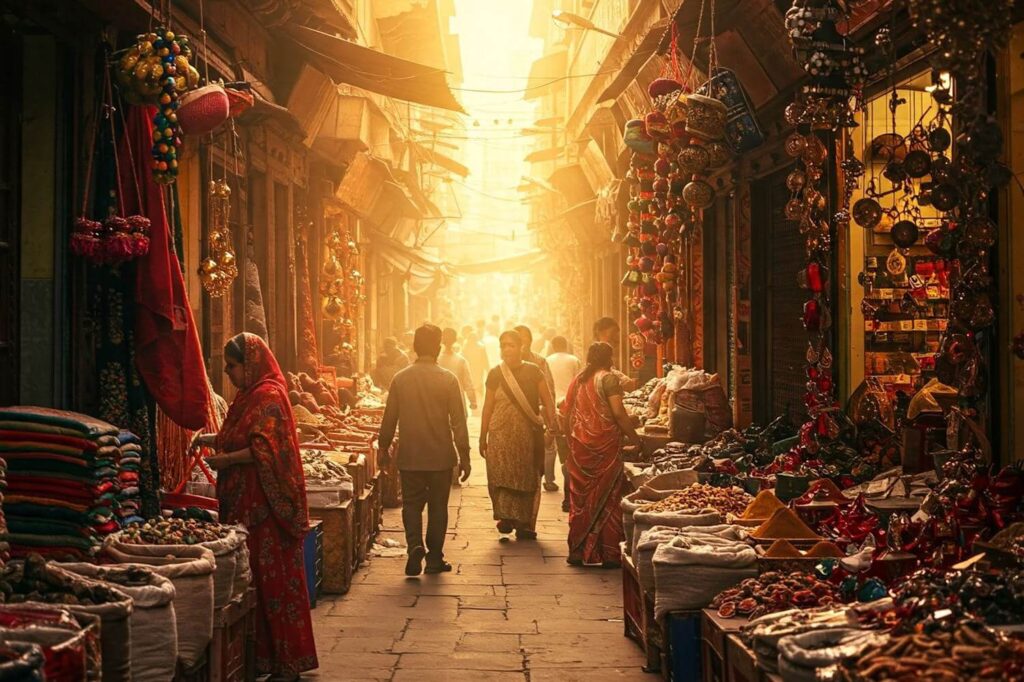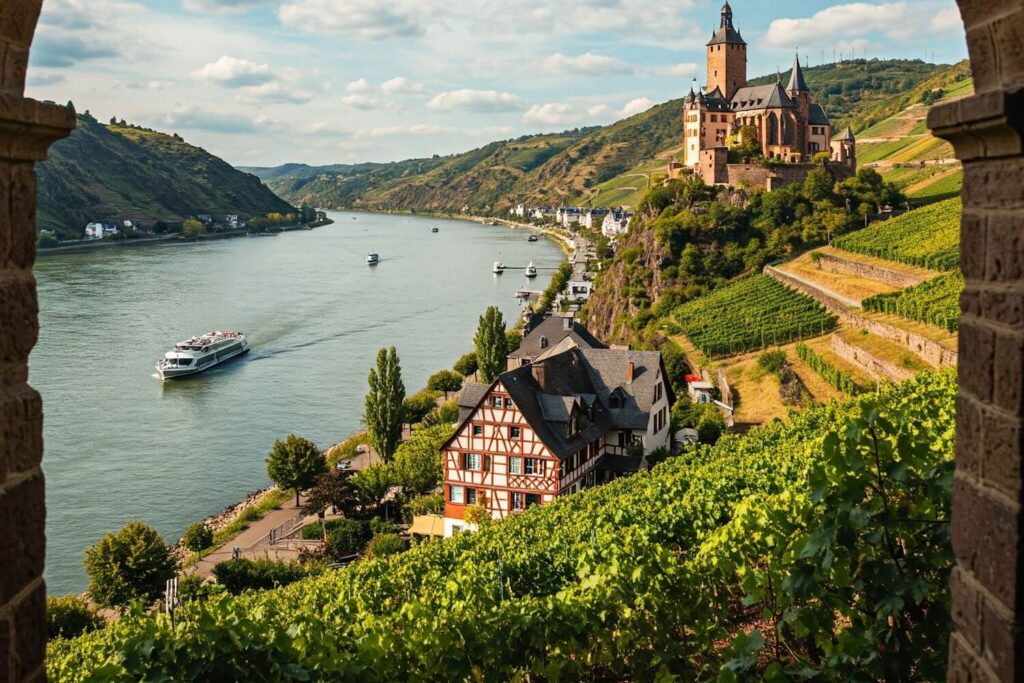Introduction to the Golden Triangle
The Golden Triangle is a prominent and exceedingly popular tourist circuit in India, encompassing three major cities: Delhi, Agra, and Jaipur. This triangular route is renowned for its rich cultural heritage, historical significance, and diverse experiences, making it an attractive destination for travelers seeking to explore the depth of Indian culture.
Delhi, the capital city of India, serves as the starting point of the Golden Triangle. It is a vibrant metropolis that combines historical landmarks with modern infrastructure. The city’s significance is marked by its extensive history, with landmarks such as the Red Fort, India Gate, and Qutub Minar showcasing its past from different eras. As a hub of politics and culture, Delhi offers visitors a glimpse into the contemporary lifestyle of India while retaining its deep-rooted traditions.
Next in the triangle is Agra, home to one of the most iconic structures in the world—the Taj Mahal. This UNESCO World Heritage site is a mausoleum built in the 17th century, symbolizing love and architectural brilliance. Beyond the Taj Mahal, Agra is rich in history, with structures like the Agra Fort and Fatehpur Sikri contributing to its cultural landscape. The city provides an intimate look at Mughal architecture and the historical narratives that shaped the region.
Lastly, Jaipur, also known as the Pink City, adds another layer of cultural richness to the Golden Triangle. Famous for its stunning palaces and forts, such as the Hawa Mahal and Amber Fort, Jaipur exemplifies royal heritage and traditional craftsmanship. The city’s vibrant markets and exquisite handicrafts further enhance its appeal, allowing travelers to engage with local artisans and their crafts.
Collectively, Delhi, Agra, and Jaipur form a mosaic of experiences that reflect India’s past and present. This cultural road trip through the Golden Triangle not only allows travelers to witness significant landmarks but also offers a unique understanding of the country’s diverse traditions, making it an essential journey for anyone looking to explore India’s heritage.
Starting in Delhi: The Heart of India
Delhi, the capital city of India, stands as a remarkable testament to the country’s rich history and vibrant culture. The city presents a unique blend of ancient heritage and modernity, making it a premier destination in India’s Golden Triangle. Among its most iconic landmarks, the Red Fort is an architectural marvel, reflecting the grandeur of Mughal history. Constructed in the 17th century, the fort is not only a UNESCO World Heritage site but also serves as a symbol of India’s struggle for independence, showcasing intricate designs and historical significance.
Another key attraction is the India Gate, a monumental arch that honors Indian soldiers who sacrificed their lives during World War I. This war memorial, surrounded by lush gardens, is an ideal spot for leisurely walks and picnics, symbolizing national pride. Additionally, the Qutub Minar, another UNESCO World Heritage site, stands as the tallest brick minaret in the world, echoing the architectural prowess of the Delhi Sultanate.
While these landmarks are essential stops for any visitor, the heart of Delhi’s charm lies in its lesser-known gems. Chandni Chowk, a bustling market area, offers an exciting glimpse into the daily lives of Delhi’s residents. Its narrow lanes are filled with vibrant shops selling everything from traditional garments to spices and delectable street food. For a truly immersive experience, exploring Chandni Chowk’s culinary offerings is a must; samples of mouth-watering parathas and sweets can be found that showcase the city’s diverse flavors.
When navigating Delhi, one can utilize the efficient metro system, which connects various attractions seamlessly. Visitors should also be sure to embrace the local culture by participating in events or festivals that highlight Delhi’s rich traditions. In essence, Delhi provides an enriching start to the fascinating journey through India’s Golden Triangle, combining historical exploration with modern urban experiences.
Agra: The City of the Taj Mahal
Agra, a vibrant city located in the northern part of India, is best known for being home to the iconic Taj Mahal, a UNESCO World Heritage Site and a paragon of Mughal architecture. Constructed between 1632 and 1653 under the reign of Emperor Shah Jahan, the Taj Mahal was built in memory of his beloved wife, Mumtaz Mahal. Its exquisite white marble façade, complemented by intricate inlay work and symmetrical gardens, attracts millions of visitors each year. The monumental structure reflects the peak of Mughal architectural brilliance, characterized by its large dome, minarets, and intricate carvings, evoking a sense of romance and eternal love.
The Taj Mahal is not only an architectural marvel but also a symbol of an enduring love story that resonates with many. To fully appreciate the beauty of this monument, the best time to visit is during the early morning or late afternoon, when sunlight enhances its ethereal glow and casts fascinating shadows over the grounds. Additionally, visiting during the cooler months of October to March is advisable, as the weather is more pleasant for outdoor exploration.
While the Taj Mahal steals the spotlight, Agra hosts several other remarkable attractions, such as the Agra Fort, another UNESCO World Heritage Site. This impressive fortification showcases a blend of Persian and Indian architectural styles with its red sandstone walls and stunning courtyard. Visitors should not miss Fatehpur Sikri, a former Mughal capital, which boasts a series of remarkably preserved palaces and mosques, illustrating the architectural grandeur of the era.
To ensure a smooth visit, it is recommended to plan ahead, purchasing tickets online to avoid long queues. Moreover, hiring a local guide can enhance the experien ce, providing valuable insights into the history and significance of each site. With its rich cultural heritage and breathtaking monuments, Agra promises a memorable excursion into India’s illustrious past.
Jaipur: The Pink City
Jaipur, often termed as the Pink City, stands as a vibrant tapestry of culture, history, and tradition, luring visitors with its stunning architecture and rich heritage. The city’s unique rosy hue, attributed to the distinct red sandstone used in its construction, adds to its allure, making it a captivating destination within India’s Golden Triangle. One of the foremost attractions, the Hawa Mahal, also known as the Palace of Winds, features an intricate façade adorned with numerous small windows, designed to allow royal women to observe street festivities while remaining unseen.
Further enriching Jaipur’s cultural narrative is the majestic Amer Fort. Nestled atop a hill, this awe-inspiring fortress showcases a harmonious blend of Rajput and Mughal architecture, drawing upon its rich history through exquisite murals, gardens, and courtyards. Here, visitors can experience an elephant ride up to the fort, a signature activity that allows for a truly immersive exploration of the site and its panoramic views of the surrounding landscape.
The bustling markets of Jaipur, such as Johari Bazaar and Bapu Bazaar, offer a sensory delight with their vibrant displays of handicrafts, textiles, and traditional jewelry. Visitors can stroll through the bazaars, immersing themselves in the local culture and perhaps bringing home a handcrafted souvenir. The local craftsman’s expertise in block printing and pottery further emphasizes Jaipur’s artistic traditions, showcasing skills passed down through generations.
Culinary experiences in Jaipur are equally captivating, with flavors that entice and excite the palate. Local delicacies such as dal baati churma and gatte ki sabzi are must-tries, providing a taste of traditional Rajasthani cuisine. To fully experience Jaipur’s culture, engaging in cooking classes or food tours is highly recommended, allowing visitors to appreciate the city’s rich gastronomic landscape. Elemental in its historical significance and modern vibrancy, Jaipur offers a complete cultural feast for every traveler.
Cultural Experiences Along the Road
Traveling through India’s Golden Triangle offers a unique opportunity to immerse oneself in a rich tapestry of cultural experiences. The journey between Delhi, Agra, and Jaipur is not merely a transit between cities, but a dive into the heart of India’s diverse traditions and customs. One of the most rewarding ways to absorb the local culture is through its culinary delights. Each city boasts a distinct culinary identity, from Delhi’s street food explosion to Agra’s delicious petha and Jaipur’s rich Rajasthani thali. Sampling these local delicacies is essential for those wishing to explore the variances in Indian cuisine and cultural expression.
Travelers can also participate in traditional festivals which are prominent throughout the year. Events such as Diwali, Holi, and Teej not only bring vibrant colors and joy but provide an excellent avenue for visitors to engage with local traditions. Many festivals feature local music, dance, and art forms that encapsulate the essence of Indian heritage, allowing participants to understand the significance of these celebrations in daily life. Being a part of these festivities reveals layers of culture often unseen in typical tourist experiences.
Additionally, engaging with local artisans is a significant aspect of this cultural journey. The Golden Triangle is home to many skilled craftsmen whose work ranges from intricate block printing in Jaipur to marble inlay work in Agra. Visitors can take part in workshops, witness the artisans at work, and even purchase handmade items, fostering a sense of connection and appreciation for their craft. Embracing these regional customs and practices not only enriches a traveler’s experience but also supports the livelihoods of local communities, making the journey through India’s Golden Triangle both meaningful and insightful.
Practical Tips for Travelers
Traveling through India’s Golden Triangle, which encompasses Delhi, Agra, and Jaipur, offers a unique opportunity to immerse oneself in the rich cultural tapestry of the region. To ensure a smooth experience, it is crucial to consider several practical tips while planning your journey.
First and foremost, transportation options vary greatly across the Golden Triangle. While trains are a popular choice for intercity travel, private taxis and ride-share services such as Uber also provide convenient alternatives. Booking train tickets in advance is advisable, especially during peak tourist seasons, to secure seating. Road travel boasts its own allure, as it allows travelers to take in the beautiful landscapes. Visitors should be aware, however, that traffic can be heavy, particularly in urban areas.
Cultural etiquette is equally important to note. It is respectful to greet locals with a polite “Namaste” and to always remove shoes before entering homes and places of worship. Additionally, modest clothing is recommended when visiting religious sites. Understanding and respecting local customs will enhance interactions and enrich your overall experience.
Safety is a paramount concern for every traveler. While the Golden Triangle is generally safe for tourists, it is advisable to take typical precautions. Keep an eye on personal belongings, avoid isolated areas after dark, and remain vigilant in crowded spaces. Utilizing reputable travel agencies or local guides can further ensure a secure and rewarding journey.
Weather conditions in the region can vary, so being aware of seasonal changes is crucial for packing adequately. The ideal time to visit is between October and March when temperatures are milder. Light clothing is suitable for the day, but travelers may need warmer attire for the evenings. A sturdy pair of walking shoes, sunscreen, and a reusable water bottle will enhance comfort and convenience during sightseeing.
By following these practical tips, travelers can navigate the Golden Triangle with ease, allowing them to focus on experiencing the fascinating cultural heritage and vibrant history that this region has to offer.
Accommodation Options and Recommendations
Traveling through India’s Golden Triangle, which encompasses Delhi, Agra, and Jaipur, presents a diverse array of accommodation choices that cater to various budgets and traveler preferences. This region is renowned not only for its iconic landmarks but also for its unique lodging experiences, ranging from opulent hotels to charming budget hostels.
In Delhi, luxury seekers can indulge in top-rated hotels such as The Oberoi and The Taj Mahal Hotel, which provide exceptional service and amenities. For a more mid-range option, consider The Lalit or Radisson Blu, which offer comfortable stays without stretching your budget excessively. Backpackers can find affordable yet cozy hostels in areas like Paharganj, such as Zostel, where they can engage with fellow travelers while enjoying a vibrant atmosphere.
Moving on to Agra, the city is famous for its heritage hotels that offer a glimpse into India’s regal past. The Oberoi Amarvilas, for instance, boasts spectacular views of the Taj Mahal, pairing luxury with cultural experiences. Budget-conscious travelers will be pleased with options like the Agra Hostel, providing both affordability and accessibility to major attractions. It is advisable to book accommodations in advance, especially during peak tourist seasons, to secure the best rates.
Lastly, in Jaipur, many visitors opt for heritage havelis converted into hotels. Places like Samode Haveli and Rambagh Palace reflect the city’s rich culture and royal heritage. Alternatively, for a genuinely local experience, consider homestays in Jaipur that allow you to immerse yourself in the local culture. The homestays often offer home-cooked meals and personalized experiences that enhance the cultural journey of the Golden Triangle.
When planning your stay, utilize online booking platforms for the best deals and verify reviews to ensure quality. Ultimately, choosing the right accommodation can significantly enhance your experience in India’s Golden Triangle, making your cultural road trip even more memorable.
Sustainable Travel Practices
As the concept of responsible tourism gains prominence, travelers venturing through India’s Golden Triangle are increasingly seeking ways to minimize their environmental impact. By adopting sustainable travel practices, tourists can play a crucial role in preserving the rich cultural heritage and natural resources of this iconic region. One of the most effective ways to contribute positively is by choosing eco-friendly accommodations. Many hotels and guesthouses in the Golden Triangle are committed to sustainability, employing practices such as energy conservation, water management, and the use of local materials. Opting for such establishments not only reduces your carbon footprint but also encourages businesses that prioritize environmental protection.
Supporting local businesses is another critical component of sustainable travel. Visitors can contribute to the economy by dining at locally-owned restaurants, purchasing handicrafts from artisans, and choosing guided tours run by residents. This approach fosters economic growth in communities and ensures that tourism dollars circulate within the local economy. By engaging with local culture, travelers also enrich their personal experiences, gaining a deeper understanding of the customs and traditions that define the Golden Triangle.
Respecting cultural sites is paramount in maintaining the integrity of these historical landmarks. Travelers should be mindful of local customs and regulations, ensuring they do not engage in activities that could damage cultural heritage or disrupt local practices. Simple actions, such as adhering to designated paths and refraining from littering, can significantly mitigate the impact on these precious sites. Additionally, travelers are encouraged to participate in community-led initiatives aimed at promoting conservation and responsible tourism. By embracing these sustainable travel practices, visitors not only enhance their own journey but also contribute to the preservation of the Golden Triangle’s remarkable cultural and environmental resources.
Conclusion: The Lasting Memories of the Golden Triangle
Traveling through India’s Golden Triangle offers an enriching experience that encapsulates the essence of the country’s vibrant culture, rich history, and architectural marvels. As explorers traverse this iconic route, they encounter a tapestry of diverse experiences that are both educational and inspiring. From the majestic beauty of the Taj Mahal in Agra to the regal heritage of Jaipur, and the spiritual ambiance of Delhi, each destination contributes uniquely to a profound understanding of India’s multifaceted identity.
The journey through the Golden Triangle serves not only as a physical road trip but also as a metaphorical voyage into the heart of an ancient civilization. Tourists often find themselves captivated by the intricate details of historical monuments, engaging tales of past leaders, and the tradition embedded in local customs. The welcoming nature of the people met along the way fosters genuine connections that enhance the overall travel experience. Such interactions remind travelers that cultural understanding and human connections are fundamental to exploring new places.
Additionally, participating in local festivals and rituals allows travelers to appreciate the depth of India’s diverse subcultures, making each visit memorable and unique. The vibrancy of the local markets, the tantalizing aromas of street food, and the rhythmic melodies of traditional music leave lasting impressions that transcend the typical tourist experience. Exploring India’s Golden Triangle thus becomes an invitation to create cherished memories and personal stories.
As visitors reflect on their journey through India’s Golden Triangle, they are encouraged to consider how the experiences gained may influence their perspectives on culture, heritage, and humanity. By embarking on their own adventure through this captivating route, readers can cultivate lasting memories that will undoubtedly enrich their lives and broaden their perspectives.





